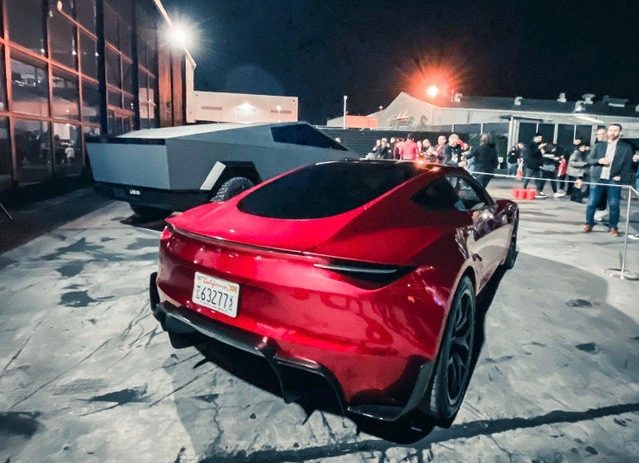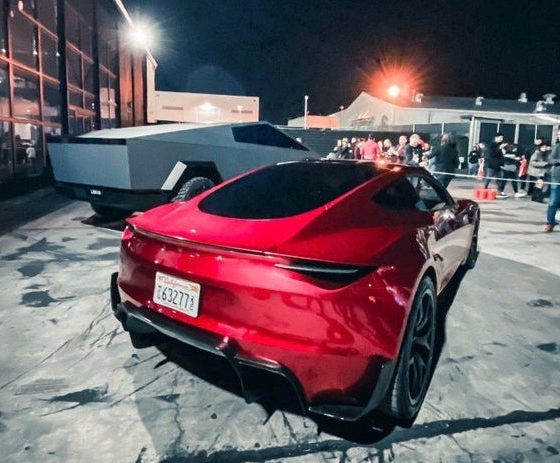

News
Tesla tops Fast Co’s list for Most Innovative Transportation company
Tesla ranked third overall in the list of The World’s 50 Most Innovative Companies by Fast Company. Tesla also topped the list of the Most Innovative Transportation Companies of 2020 by the same publication.
The Silicon Valley-based carmaker finished just behind social media platform Snap and tech-giant Microsoft, which finished first and second, respectively. In the transportation sector, Tesla grabbed the top spot while Brightline/Virgin Trains, the first new privately-held passenger rail system in the United States in 100 years, finished second. Software company Swiftly, which helps cities optimize public transit systems using data analysis snagged the third spot.
Fast Company cited Tesla “for proving it’s a mass-market automaker by delivering more than 350,000 cars in 2019. Tesla proved it can compete with Big Auto when it delivered 367,500 vehicles to customers last year—more than double the number of cars it sold in the previous two years. It also opened a new factory in China, and began delivering cars to the world’s largest EV market.”
Aptiv came in fourth and was cited for completing more than 70,000 paid autonomous car rides with Lyft. Electric vehicle charging company Chargepoint got the fifth spot. Kodiak Robotics, Passport, Shipex, Cake, and LM Industries completed the top 10 in the transport sector
The publication highlights the achievements and promising ideas of the biggest and lesser-known industry players, but more importantly, puts the spotlight on how Elon Musk’s car company has been reshaping itself as an industry leader and how it continues to transform the the car industry as a whole.
Scaling up production of its vehicles, focused at the moment on the Model 3 electric sedan and now the Model Y electric crossover is an integral step to achieving Tesla’s mission of fostering a wider adoption of electric vehicles. For 2020, Tesla is aiming to deliver 500,000 vehicles.
While these numbers may sound ambitious to the company’s naysayers, it is a realistic goal with the carmaker eyeing production of 500K units per year in its Fremont factory once upgrades are completed mid-year. Giga Shanghai, according to a recent record of meetings between investors and experts, is expected to hit 170,000 vehicles this year, with an aim to produce 5,000 vehicles per week putting the facility all the way up to to almost 250,000 units annually.
Aside from its connected cars, it also continues to invest in improving its car battery technologies. Industry leaders and major players are awaiting what Tesla and Elon Musk would announce during its Battery Day in April. It could be about mass production of cheaper batteries or perhaps enhanced batteries for its existing and future vehicles, and while these could spell doomsday for other legacy automakers it opens the possibility of Tesla helping everyone as a supplier of reliable electric vehicle batteries in the future. If that happens, it would be a win-win situation for carmakers and the environment as this would make green cars from different brands more attractive to consumers. Tesla’s innovation is effectively innovation for the car industry as a whole.
Ramping production has indeed turned Tesla into a mass vehicle producer, but more importantly, it brings it a step closer to helping the world achieve a more sustainable future through its products.
“When I think what we have in front of us, the next couple of years, we’ve got Model Y, we’ve got Giga Berlin, Tesla Semi, Solarglass Roof, Cybertruck some very exciting improvements in battery technology,” Elon Musk said during its Q4 2019 earnings call. “It’s hard to think of another company that has more exciting product and technology roadmap. So super-fired up about where Tesla will be in the next 10 years.”
Fast Company’s list of The World’s Most Innovative Companies looked into groundbreaking businesses in 44 sectors across different regions of the globe. The nominated companies were assessed by the publication’s editors and writers based on their innovation and impact, with focus on their accomplishments in the past year.

News
Tesla FSD fleet is nearing 7 billion total miles, including 2.5 billion city miles
As can be seen on Tesla’s official FSD webpage, vehicles equipped with the system have now navigated over 6.99 billion miles.

Tesla’s Full Self-Driving (Supervised) fleet is closing in on almost 7 billion total miles driven, as per data posted by the company on its official FSD webpage.
These figures hint at the massive scale of data fueling Tesla’s rapid FSD improvements, which have been quite notable as of late.
FSD mileage milestones
As can be seen on Tesla’s official FSD webpage, vehicles equipped with the system have now navigated over 6.99 billion miles. Tesla owner and avid FSD tester Whole Mars Catalog also shared a screenshot indicating that from the nearly 7 billion miles traveled by the FSD fleet, more than 2.5 billion miles were driven inside cities.
City miles are particularly valuable for complex urban scenarios like unprotected turns, pedestrian interactions, and traffic lights. This is also the difference-maker for FSD, as only complex solutions, such as Waymo’s self-driving taxis, operate similarly on inner-city streets. And even then, incidents such as the San Francisco blackouts have proven challenging for sensor-rich vehicles like Waymos.
Tesla’s data edge
Tesla has a number of advantages in the autonomous vehicle sector, one of which is the size of its fleet and the number of vehicles training FSD on real-world roads. Tesla’s nearly 7 billion FSD miles then allow the company to roll out updates that make its vehicles behave like they are being driven by experienced drivers, even if they are operating on their own.
So notable are Tesla’s improvements to FSD that NVIDIA Director of Robotics Jim Fan, after experiencing FSD v14, noted that the system is the first AI that passes what he described as a “Physical Turing Test.”
“Despite knowing exactly how robot learning works, I still find it magical watching the steering wheel turn by itself. First it feels surreal, next it becomes routine. Then, like the smartphone, taking it away actively hurts. This is how humanity gets rewired and glued to god-like technologies,” Fan wrote in a post on X.
News
Tesla starts showing how FSD will change lives in Europe
Local officials tested the system on narrow country roads and were impressed by FSD’s smooth, human-like driving, with some calling the service a game-changer for everyday life in areas that are far from urban centers.

Tesla has launched Europe’s first public shuttle service using Full Self-Driving (Supervised) in the rural Eifelkreis Bitburg-Prüm region of Germany, demonstrating how the technology can restore independence and mobility for people who struggle with limited transport options.
Local officials tested the system on narrow country roads and were impressed by FSD’s smooth, human-like driving, with some calling the service a game-changer for everyday life in areas that are far from urban centers.
Officials see real impact on rural residents
Arzfeld Mayor Johannes Kuhl and District Administrator Andreas Kruppert personally tested the Tesla shuttle service. This allowed them to see just how well FSD navigated winding lanes and rural roads confidently. Kruppert said, “Autonomous driving sounds like science fiction to many, but we simply see here that it works totally well in rural regions too.” Kuhl, for his part, also noted that FSD “feels like a very experienced driver.”
The pilot complements the area’s “Citizen Bus” program, which provides on-demand rides for elderly residents who can no longer drive themselves. Tesla Europe shared a video of a demonstration of the service, highlighting how FSD gives people their freedom back, even in places where public transport is not as prevalent.
What the Ministry for Economic Affairs and Transport says
Rhineland-Palatinate’s Minister Daniela Schmitt supported the project, praising the collaboration that made this “first of its kind in Europe” possible. As per the ministry, the rural rollout for the service shows FSD’s potential beyond major cities, and it delivers tangible benefits like grocery runs, doctor visits, and social connections for isolated residents.
“Reliable and flexible mobility is especially vital in rural areas. With the launch of a shuttle service using self-driving vehicles (FSD supervised) by Tesla in the Eifelkreis Bitburg-Prüm, an innovative pilot project is now getting underway that complements local community bus services. It is the first project of its kind in Europe.
“The result is a real gain for rural mobility: greater accessibility, more flexibility and tangible benefits for everyday life. A strong signal for innovation, cooperation and future-oriented mobility beyond urban centers,” the ministry wrote in a LinkedIn post.
News
Tesla China quietly posts Robotaxi-related job listing
Tesla China is currently seeking a Low Voltage Electrical Engineer to work on circuit board design for the company’s autonomous vehicles.

Tesla has posted a new job listing in Shanghai explicitly tied to its Robotaxi program, fueling speculation that the company is preparing to launch its dedicated autonomous ride-hailing service in China.
As noted in the listing, Tesla China is currently seeking a Low Voltage Electrical Engineer to work on circuit board design for the company’s autonomous vehicles.
Robotaxi-specific role
The listing, which was shared on social media platform X by industry watcher @tslaming, suggested that Tesla China is looking to fill the role urgently. The job listing itself specifically mentions that the person hired for the role will be working on the Low Voltage Hardware team, which would design the circuit boards that would serve as the nervous system of the Robotaxi.
Key tasks for the role, as indicated in the job listing, include collaboration with PCB layout, firmware, mechanical, program management, and validation teams, among other responsibilities. The role is based in Shanghai.
China Robotaxi launch
China represents a massive potential market for robotaxis, with its dense urban centers and supportive policies in select cities. Tesla has limited permission to roll out FSD in the country, though despite this, its vehicles have been hailed as among the best in the market when it comes to autonomous features. So far, at least, it appears that China supports Tesla’s FSD and Robotaxi rollout.
This was hinted at in November, when Tesla brought the Cybercab to the 8th China International Import Expo (CIIE) in Shanghai, marking the first time that the autonomous two-seater was brought to the Asia-Pacific region. The vehicle, despite not having a release date in China, received a significant amount of interest among the event’s attendees.








